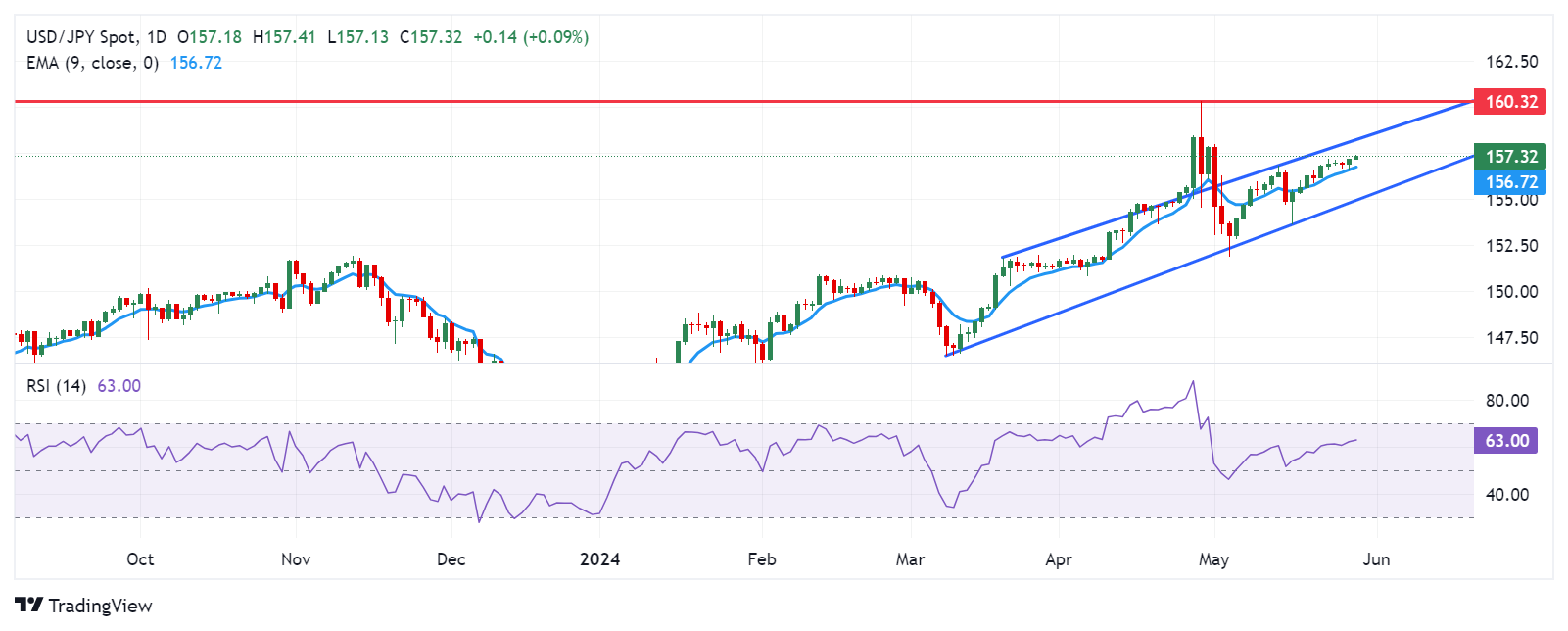- The Japanese Yen gains ground as BoJ Adachi emphasizes bond-buying reduction.
- The emergence of risk aversion has supported the US Dollar.
- Minneapolis Fed President Neel Kashkari suggested the possibility of a rate hike.
The Japanese Yen (JPY) recovered intraday losses that were influenced by a broad market downturn driven by risk aversion sentiment. The Yen bounced back after Bank of Japan (BoJ) board member Seiji Adachi emphasized reducing bond buying in several stages so that long-term yields better serve as a market signal. However, Adachi didn't provide any timeline for the same. Over the interest rate outlook, Adachi commented that it would be appropriate to adjust interest rates at a slow pace if underlying inflation steadily moves toward 2%, per Reuters
In his earlier comments, BoJ’s Adachi emphasized the potential consequences of frequent changes in monetary policy to stabilize foreign exchange movements, warning that significant fluctuations in interest rates could disrupt household and corporate investment. Adachi also highlighted that the BoJ has yet to be convinced of sustained achievement regarding its price target, hence the necessity to uphold accommodative conditions.
Meanwhile, the US Dollar (USD) saw a resurgence following remarks by Neel Kashkari, President of the Federal Reserve Bank of Minneapolis, hinting at the possibility of a rate hike. Kashkari remarked, “I don’t believe anyone has completely ruled out the option of increasing rates,” expressing doubts about the disinflationary trend and projecting only two rate cuts.
Fed's Beige Book will be released on Wednesday, providing an overview of the current US economic situation based on interviews with key business contacts, economists, market experts, and other sources from the 12 Federal Reserve Districts.
Daily Digest Market Movers: Japanese Yen loses revives even though US Dollar holds recovery
- Traders await the release of the US Gross Domestic Product Annualized (Q1) and Core Personal Consumption Expenditures (PCE) Price Index data later in the week. These high-impact releases are expected to provide cues on potential rate cuts from the Federal Reserve (Fed).
- On Tuesday, the US Housing Price Index (MoM) for March was underperforming, with March's number coming in at 0.1% against 1.2% for February, where 0.5% was expected.
- Japan's Weighted Median Inflation Index, a significant gauge of the country’s trend inflation, increased by 1.1% in April. This growth rate represents a slowdown from the 1.3% increase recorded in March.
- Japan’s Corporate Service Price Index (CSPI). The index posted a year-over-year reading of 2.8% in April, surpassing expectations of 2.3% and marking its fastest rate of increase since March 2015.
- Japan Finance Minister Shun'ichi Suzuki on Tuesday, emphasized the importance of currencies moving in a stable manner that reflects fundamentals, stating that he is closely monitoring foreign exchange (FX) movements. However, Suzuki refrained from commenting on whether Japan has conducted currency intervention.
- At the 2024 BOJ-IMES Conference on Tuesday, Cleveland Federal Reserve President Loretta Mester emphasized the importance of FOMC statements providing a detailed description of the current assessment of the economy, its influence on the outlook, and the associated risks. Mester expects that the Fed will consider enhancing communications as part of its next monetary policy framework review.
- Meanwhile, Federal Reserve (Fed) Governor Michelle Bowman highlighted the significance of continuing to reduce the balance sheet size to achieve ample reserves as quickly as possible, particularly while the economy remains robust. Bowman emphasized the importance of communicating any changes to the run-off rate to ensure it is clear that they do not signify a shift in the Fed's monetary policy stance.
- On Monday, BoJ Governor Kazuo Ueda remarked that progress has been made in moving away from zero and raising inflation expectations, but there is a need to re-anchor them, this time at the 2% target. Additionally, BoJ Deputy Governor Shinichi Uchida stated that they have reverted to a conventional monetary policy framework to achieve a 2% price stability target through adjustments of the short-term policy rate.
- In its report on Monday, the Japanese Cabinet Office stated that the government maintained its view on the economy unchanged for the third consecutive month in May. It noted that the Japanese economy continues to recover at a moderate pace, although there are signs of a recent pause in growth.
Technical Analysis: USD/JPY trades close to 157.00
The USD/JPY pair trades around 157.00 on Wednesday. The daily chart shows a rising channel pattern, indicating the continuation of an upward trend in the market. Additionally, the 14-day Relative Strength Index (RSI) remains above 50, confirming a bullish bias.
The USD/JPY pair may potentially test the psychological level of 158.00, which aligns with the upper boundary of the rising channel. If this level is breached, the next target could be 160.32, marking its highest point in over thirty years.
On the downside, the nine-day Exponential Moving Average (EMA) at 156.72 acts as immediate support, followed by the psychological level of 156.00. Further decline in the USD/JPY pair could apply downward pressure, potentially testing the lower boundary of the rising channel.
USD/JPY: Daily Chart
Japanese Yen price today
The table below shows the percentage change of the Japanese Yen (JPY) against the major listed currencies today. Japanese Yen was the strongest against the New Zealand Dollar.
| USD | EUR | GBP | CAD | AUD | JPY | NZD | CHF | |
| USD | -0.03% | -0.06% | 0.07% | -0.12% | -0.09% | 0.01% | -0.04% | |
| EUR | 0.01% | -0.04% | 0.09% | -0.10% | -0.07% | 0.04% | -0.03% | |
| GBP | 0.07% | 0.05% | 0.13% | -0.07% | -0.03% | 0.07% | 0.01% | |
| CAD | -0.06% | -0.07% | -0.10% | -0.20% | -0.15% | -0.05% | -0.11% | |
| AUD | 0.12% | 0.11% | 0.08% | 0.20% | 0.06% | 0.14% | 0.12% | |
| JPY | 0.09% | 0.07% | 0.02% | 0.13% | -0.05% | 0.13% | 0.04% | |
| NZD | -0.01% | -0.03% | -0.07% | 0.05% | -0.15% | -0.10% | -0.09% | |
| CHF | 0.02% | 0.01% | -0.01% | 0.11% | -0.11% | -0.04% | 0.06% |
The heat map shows percentage changes of major currencies against each other. The base currency is picked from the left column, while the quote currency is picked from the top row. For example, if you pick the Euro from the left column and move along the horizontal line to the Japanese Yen, the percentage change displayed in the box will represent EUR (base)/JPY (quote).
Japanese Yen FAQs
The Japanese Yen (JPY) is one of the world’s most traded currencies. Its value is broadly determined by the performance of the Japanese economy, but more specifically by the Bank of Japan’s policy, the differential between Japanese and US bond yields, or risk sentiment among traders, among other factors.
One of the Bank of Japan’s mandates is currency control, so its moves are key for the Yen. The BoJ has directly intervened in currency markets sometimes, generally to lower the value of the Yen, although it refrains from doing it often due to political concerns of its main trading partners. The current BoJ ultra-loose monetary policy, based on massive stimulus to the economy, has caused the Yen to depreciate against its main currency peers. This process has exacerbated more recently due to an increasing policy divergence between the Bank of Japan and other main central banks, which have opted to increase interest rates sharply to fight decades-high levels of inflation.
The BoJ’s stance of sticking to ultra-loose monetary policy has led to a widening policy divergence with other central banks, particularly with the US Federal Reserve. This supports a widening of the differential between the 10-year US and Japanese bonds, which favors the US Dollar against the Japanese Yen.
The Japanese Yen is often seen as a safe-haven investment. This means that in times of market stress, investors are more likely to put their money in the Japanese currency due to its supposed reliability and stability. Turbulent times are likely to strengthen the Yen’s value against other currencies seen as more risky to invest in.
Information on these pages contains forward-looking statements that involve risks and uncertainties. Markets and instruments profiled on this page are for informational purposes only and should not in any way come across as a recommendation to buy or sell in these assets. You should do your own thorough research before making any investment decisions. FXStreet does not in any way guarantee that this information is free from mistakes, errors, or material misstatements. It also does not guarantee that this information is of a timely nature. Investing in Open Markets involves a great deal of risk, including the loss of all or a portion of your investment, as well as emotional distress. All risks, losses and costs associated with investing, including total loss of principal, are your responsibility. The views and opinions expressed in this article are those of the authors and do not necessarily reflect the official policy or position of FXStreet nor its advertisers. The author will not be held responsible for information that is found at the end of links posted on this page.
If not otherwise explicitly mentioned in the body of the article, at the time of writing, the author has no position in any stock mentioned in this article and no business relationship with any company mentioned. The author has not received compensation for writing this article, other than from FXStreet.
FXStreet and the author do not provide personalized recommendations. The author makes no representations as to the accuracy, completeness, or suitability of this information. FXStreet and the author will not be liable for any errors, omissions or any losses, injuries or damages arising from this information and its display or use. Errors and omissions excepted.
The author and FXStreet are not registered investment advisors and nothing in this article is intended to be investment advice.
Recommended content
Editors’ Picks

Gold refreshes all-time highs above $3,000 on escalating geopolitical tensions
Gold price is reneweing record highs beyond $3,000 early Tuesday on intensifying geopolitical Middle East tensions. Israel resumes military operations against Hamas in Gaza after the group rejected US proposals for extending ceasefire. Further US-Iran tensions add to the latest leg up in the safe-haven Gold.

AUD/USD trades with caution below 0.6400 amid MiIddle East tensions
AUD/USD has paused its upsurge, trading with caution in Tuesday's Asian trading. Traders prefer to stay on the sidelines amid intensifying geopolitical risks in the Middle East, reducing the appeal of the higher-yielding Aussie. Meanwhile, the US Dollar finds its feet due to risk aversion.

USD/JPY sits at two-week high near 149.50 as US Dollar finds demand
USD/JPY sits at two-week high near 149.50 in the Asian session on Tuesday as renewed Middle East geopolitical jitters revive the safe-haven demand for the US Dollar. However, further upside appears elusive amid divergent BoJ-Fed expectations and rising trade tensions.

Solana price faces 50-day resistance as SOL futures debut on CME Group with $5M volume on fifth anniversary
Solana stagnated around the $128 mark on Monday despite multiple bullish catalysts. The recent SOL unlocks by Alameda Research, ahead of FTX creditor repayments, have created a persistent bearish overhang since early March.

Five Fundamentals for the week: Fed leads central bank parade as uncertainty remains extreme Premium
Central bank bonanza – perhaps its is not as exciting as comments from the White House, but central banks still have sway. They have a chance to share insights about the impact of tariffs, especially when they come from the world's most powerful central bank, the Fed.

The Best brokers to trade EUR/USD
SPONSORED Discover the top brokers for trading EUR/USD in 2025. Our list features brokers with competitive spreads, fast execution, and powerful platforms. Whether you're a beginner or an expert, find the right partner to navigate the dynamic Forex market.
